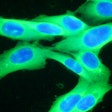
Combining nanopores and nanobodies facilitates the detection of protein biomarkers in blood samples, according to a study published recently in ACS Nano.
The collaboration between researchers at Groningen University in the Netherlands and Aarhus University in Denmark explored the combination of two emerging technologies. Nanopores are tiny channels that were initially developed for DNA sequencing and other label-free biomolecular sensing techniques. As a molecule enters the channel, it alters the flow of ions. Analyzing the changes reveals the presence of the molecule and facilitates the detection of DNA, RNA, and other analytes.
Nanobodies are single-domain antibody fragments. Like whole antibodies, nanobodies bind to specific antigens and, as such, biopharma companies are developing the molecules to treat diseases. The small size of nanobodies can result in better solubility, stability, and tissue penetration than antibodies.
For the ACS Nano paper, the researchers combined a ClyA nanopore with nanobodies designed to bind to proteins associated with certain diseases. DNA linkers connected the nanopores and nanobodies. The combination was underpinned by the hypothesis that the nanobodies would alter the ionic flux when they bound to their target proteins, thereby causing a change in the current that the researchers could detect. If the current changed, the team would know a particular protein was present.
The team tested the idea using nanobodies against the SARS-CoV-2 Spike protein, the HER2 receptor, and the murine urokinase-type plasminogen activator (muPA). The proteins range in size from the large viral Spike protein to the small muPA biomarker associated with cancer progression. HER2 is a medium-sized protein that is highly expressed in some breast cancer patients.
Applying the approach to proteins ranging in size from tens to hundreds of kilodaltons allowed the team to show the versatility of the sensing platform, as the researchers wrote in the journal paper.
“Detection of various-sized proteins follows different mechanisms, where the engagement of large proteins retains the nanobodies outside of the pore, increasing the current through the open pore, whereas small proteins complexing with the nanobodies were dragged into the pore, generating larger blockade signals,” the researchers wrote. “These findings suggest that various proteins regardless of their sizes, shapes and charges can be detected by the nanobody-functionalized nanopore platform.”
The platform could reliably detect biomarkers, bacteria, or viruses in biofluids such as blood samples taken from patients. The ability to detect target proteins in complex mixtures of molecules is enabled by the nanobodies, which act as gatekeepers and stop most molecules from entering the nanopores.



















